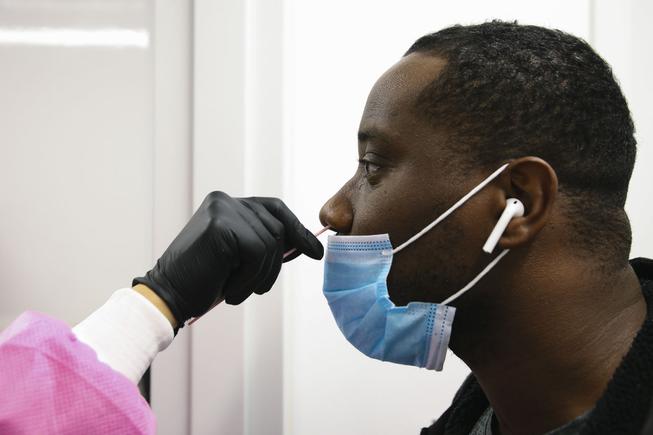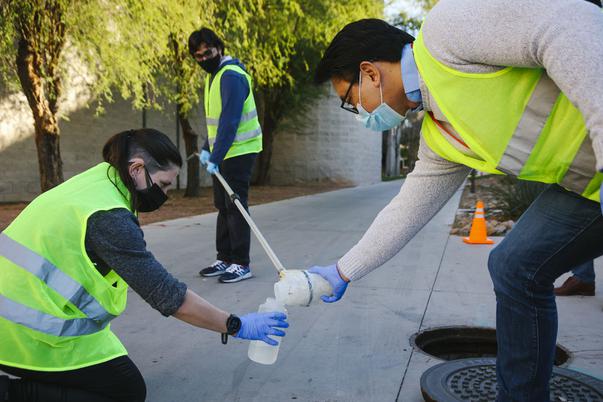
Mark Jefferson receives a COVID test from contact tracer Lily Dominguez at the Southern Nevada Health District Wednesday, Jan. 5, 2022.
Thursday, March 17, 2022 | 2 a.m.
Two years ago today, Samantha Smith was working as an associated patient care coordinator in an outpatient primary care office when Gov. Steve Sisolak announced mitigation efforts against the COVID-19 pandemic.
While many other industries shuttered in an attempt to limit the virus spread, Smith and other health care providers went to work to serve patients in need.
Now a research analyst for the Nevada Institute for Children’s Research and Policy, those early-pandemic experiences tending to a variety of patients in adult medicine fueled Smith’s interest in researching how COVID-19 is affecting different groups across the Las Vegas community.
The institute forms local partnerships to increase vaccine access and education to ensure that all residents can access equal care during the ongoing pandemic, Smith said.
“Health equity is about us being able to have these conversations, especially tough conversations, but, you know, being able to come up with solutions that work best for the community,” she said.
The hospitalization rate disparity brought on by the pandemic among Black, Latino, and Native persons when compared with the white population was pronounced, according to the Centers for Disease Control and Prevention.
Native Americans had the highest hospitalization rate — approximately 2,017 per 100,000 people nationally, while Blacks had the second-highest rate at 1,576 hospitalizations per 100,000. Hispanics and Latinos were at 1,507 per 100,000. Hospitalizations among whites were around 656 per 100,000.
Census data from 2020 shows that of the 331,893,745 people who lived in the United States, white people accounted for 76.3% of the population, with Hispanics or Latinos comprising 18.5%, Blacks making up 13.4%, Asians 5.9% and American Indian or Alaska Natives at 1.3%. Higher hospitalization and death rates among groups with smaller population sizes indicate a disparity in COVID-19’s impact. (The percentages add up to over 100% because some people identify as more than one category.)
Smith said her research focused on seven groups more severely affected by the pandemic — Black, Native American, Latino, hearing impaired, LGBT, Asian, and Hawaiian and Pacific Islander communities — and aimed to address and rescind barriers to access health care during the pandemic.
This means direct, clear messaging to educate these groups about the vaccine, especially those less trusting of the government. It also means providing access to the vaccine, including hosting clinics where no identification was required, as some undocumented residents avoid necessary public health services because of immigration fears.
“Quick changes and the delivery of information ... sometimes causes confusion and then also just frustration for patients,” she said. “I take a step back and try to really look and see, like, OK, I guess we understand that this information has changed, but is this the best way to deliver it?”
The Southern Nevada Health District announced Wednesday it was awarded a five-year national accreditation through the Public Health Accreditation Board.
“This announcement should also underscore for the community how unwavering our commitment has been to maintain services and improve our performance in the midst of the unprecedented response to the COVID-19 pandemic,” Dr. Fermin Leguen, SNHD district health officer, said in a statement.
The past two years, SNHD has updated COVID-19 case counts daily, but it announced March 11 it would scale down to weekly updates. This transition is akin to typical disease surveillance reporting and shows the state’s progression related to the virus, the health district said in a news release.
In a statement to the Sun, SNHD said Clark County’s declining metrics are encouraging. But this is also the result of two years of strenuous work, which included making available antiviral treatments, self-test kits and COVID-19 vaccines; providing guidelines for masks and social distancing; creating massive and small-scale COVID-19 test and vaccine administration locations; and developing surveillance tools.
“In the past two years, the Health District’s response has evolved as more information became available and we learned more about the virus itself,” it said in the statement. “There has been a tremendous effort by Health District employees during the pandemic and staff continues to respond to COVID-19 as well as provide other public health services.”
Fathoming two years of the novel virus was a situation hard to picture in 2020, said David Perez, equity and community director at Immunize Nevada.
Equity has also come to define Perez’s seven years of work at the nonprofit, where the group promotes COVID-19 testing and vaccine clinics across the valley through local partnerships like SNHD, the Nevada Vaccine Equity Collaborative, the UNLV Kirk Kerkorian School of Medicine and the Nevada Minority Health and Equity Coalition.
This work goes beyond COVID-19 vaccines, Perez said. Immunize Nevada also touts vaccine clinics for the flu and shingles.
“We saw that those who are getting vaccinated were not in areas that were being most affected (by) COVID,” he said. “It was just a compilation of statewide agencies making sure that we can bring in community partners so we could focus their needs as they were beginning to set up community clinics or, you know, virtual outreach events where they could promote information regarding those vaccines.”
At University Medical Center, medical ICU director Dr. Angie Honsberg said a standout achievement from the past two years of the pandemic is doctors’ ability to better manage acute respiratory distress syndrome (ARDS), the number of which she called “unprecedented.”
What also weighs heavily on her, informed by her time in the ICU, is the patients who have been hospitalized with the virus because they did not receive a COVID-19 vaccine. This disproportionately affects people of color and the poor.
“One of the regrets I have now is that we still get people who are not vaccinated, and unfortunately have a very poor outcome because of that,” she said. “I hope that from a public policy standpoint, we’re better able to address some of those disparities.”
When reflecting on a future with COVID-19, Smith said she thinks “we’re going to have to find ways to continue to live with it.”
Efforts in the UNLV medical school by students and professors are making that prediction more tangible. Edwin Oh, the associate professor who directs the university’s wastewater surveillance program, said it is encouraging to see the CDC using wastewater data in its scrutiny of the pandemic. Bloomberg reported Tuesday a growth in COVID-19 cases in CDC wastewater data, but Oh said the small increase is not something to worry about.
From March 1-10, Clark County showed a 100% to 999% increase in cases, a prediction Oh said might be overstated. Roughly one week of increases, he said, would not indicate a surge is coming, and a picture of about five weeks of increases is a better measure of what could come.
Oh also said he thinks the CDC might also only have one or two wastewater sites in Southern Nevada to represent the county, while the UNLV wastewater program tracks several sites in Henderson, unincorporated Clark County, Las Vegas and North Las Vegas.
“Wastewater viral levels right now are pretty much all-time lows,” he said. “Every state is a little different. So I think we’re going see some spikes, and some people might think it’s something that we should be concerned about, but it might not necessarily be a big deal.”

